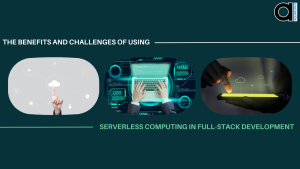The Benefits And Challenges Of Using Serverless Computing In Full-Stack Development

Serverless means operating a company’s IT infrastructure through third parties instead of utilising an on-site IT architecture. A few benefits include less server administration, no initial setup, increased scalability to accommodate traffic demands, and cost-effectiveness.
What is Serverless Computing?
Thanks to serverless computing, developers no longer have to think about any back-end activities when creating serverless applications or websites.
The viewable, engaging, and distinctive components comprise a web app’s front end. The aesthetics, typography, user interface, and other graphic cues are included here.
The parts of a website or app’s back-end that users do not see but are essential for a flawless online experience are called. These supporting elements could include:
- Data files: The back end must contain data files that list available item inventories, open storefront locations, and blog post listings.
- Processing: While most data processing occurs behind the scenes, every action a consumer takes uses a tiny bit of electricity.
- Security: A user might need to log in to view specific components. While the functionality is on the back end, the registration page is on the front.
With the help of serverless computing, software developers may create and deploy apps without bothering about the core tech. In contrast to managing servers, operating systems, and virtual machines, serverless computing focuses developers’ attention on building code for specialised functions or services that use in the cloud.
Although servers are still used to run the applications, the term “serverless” is slightly misleading. Nevertheless, the cloud provider wholly handles the infrastructure and resource provisioning, application scaling, and availability management.
For event-driven applications, where code is activated by specific events like a user downloading a file or a message arriving in a queue, serverless computing is frequently employed. By the volume of events, the cloud provider manages the resources needed to execute the application, scaling up or down as necessary.
This article will examine the advantages and difficulties of adopting serverless computing in full-stack development.
Serverless Computing- Benefits
There are many advantages to serverless computing over traditional server-centric design. Serverless architectures, in the opinion of many programmers, provide more significant scale, flexibility, a quicker time to market, and lower cost deployment. Thanks to serverless designs, developers don’t have to buy, deploy, or operate back-end servers. Yet, serverless computing is not a miracle cure for most web application developers.
Lower Expenses
By using serverless computing, developers may avoid paying for a set amount of infrastructure despite consumption and only pay for the resources they use. Costs can be drastically decreased in this way, particularly for applications with erratic usage patterns. Hire full-stack developer who can save operating expenses because they don’t have to handle the infrastructure.
Scalability
Applications may scale autonomously based on demand thanks to serverless computing. Cloud providers automatically deploy resources as required to ensure that apps can handle sudden increases in traffic without going offline or performing worse. This makes it simple to create highly scalable apps without being concerned about infrastructure management or capacity planning.
Decreased Operational Costs
The fact that managing servers and infrastructure are substantially less work, thanks to serverless computing, is one of its most significant advantages. With serverless computing, developers may avoid worrying about administering operating systems, patching software, or deploying servers. This frees up developers to concentrate on producing features and creating code.
Shortened Time To Market
With serverless computing, it is simpler to release apps quickly. Developers can concentrate on writing code and delivering features because they don’t have to worry about infrastructure. Getting products to market more rapidly can aid businesses in gaining a competitive advantage.
Increased Dependability
Because cloud service providers oversee the infrastructure needed to execute the application, serverless computing can be highly dependable. Developers may now concentrate on developing code rather than running servers, which can assist in guaranteeing the application’s high availability and dependability.
Easier Deployment
Application deployment may be significantly easier with serverless computing than with conventional infrastructure. Developers only need to upload their code to the cloud provider’s platform; the provider will handle the rest. Hire full-stack developer to save time and decrease the possibility of deployment problems.
Serverless Computing- Limitations
Full-stack development benefits significantly from serverless computing, but there are also significant difficulties that developers must work around.
Cold Start Intervals
Cold start times are one of the main problems with serverless computing. The cloud provider must set up the necessary resources to run a function when it is called for the first time. The user experience may be impacted if there is a delay before the process begins to run as a result of this. Maintaining functions warm, which entails periodically activating them to keep the resources provisioned, might reduce this time.
Few Alternatives For Runtime
Comparing serverless computing platforms to traditional infrastructure, the runtime options are frequently more constrained. The languages, frameworks, and libraries developers can use may be constrained. Also, some applications could call for particular setups that are impossible in serverless systems.
Vendor Lock-in
Cloud companies’ provision of serverless computing environments may lead to vendor lock-in. It could be challenging to migrate an application from one cloud provider’s serverless platform to another or an on-premises climate if it was developed on that platform.
Debugging and Testing
Testing and debugging serverless apps can be difficult, mainly when using intricate event-driven structures. There are still many undiscovered vulnerabilities in serverless applications, so finding and fixing them might be challenging for developers.
Wrapping Up
As serverless computing is event-driven, developers create states as I/O queries processed by compute units and then removed. The process is fully automated and doesn’t need human involvement or upkeep like a typical server.
This makes serverless computing alternatives resource-efficient, affordable, and friendly ways to create and use apps.
Serverless computing has potential benefits for every industry, including finance, education, and even politics. This suggests that soon, your workers and clients may ask for serverless solutions.
Serverless computing is the ideal answer for those who wish to develop event-based systems more quickly and efficiently while maximising effectiveness and productivity. Hire full-stack developer from Aquarious Technology to fulfil your coding dreams.
-
14
+Category
-
98
+Post
Top Categories
Popular Posts
- The Power of Prototyping in Software Development
- Version Control Best Practices for App Development
- Understanding Visual Hierarchy: A Guide to Effective Design
- Crafting Intuitive Navigation: A Guide to Seamless User Experience
- Choose Your Best Cloud Provider
- Making the Leap: Transitioning from Manual to Automated Software Testing
- Using GitHub- Advantages and Disadvantages
- E-commerce Product Photography on a Budget
- Tech Innovation in Developing Countries
- Smart Cities: How Technology is Shaping the Urban Landscape
- Principles of Composition: Creating Visual Harmony with Composition
- Exploring Cross-Platform App Development
- Why Regular Website Updates Matter
- Navigating Effective Facebook Audience Targeting
- Implementing Ads for Game Monetization
- Designing User-Centric Mental Health Apps: Enhancing Well-being in the Digital Age
- NFTs and Collectibles: Creating NFT App Solutions for Collectors and Enthusiasts
- Successful Implementation of Enterprise Apps
- Maximizing Business Impact with EQ
- Proven SMO Ads Optimization Tips (2023)






